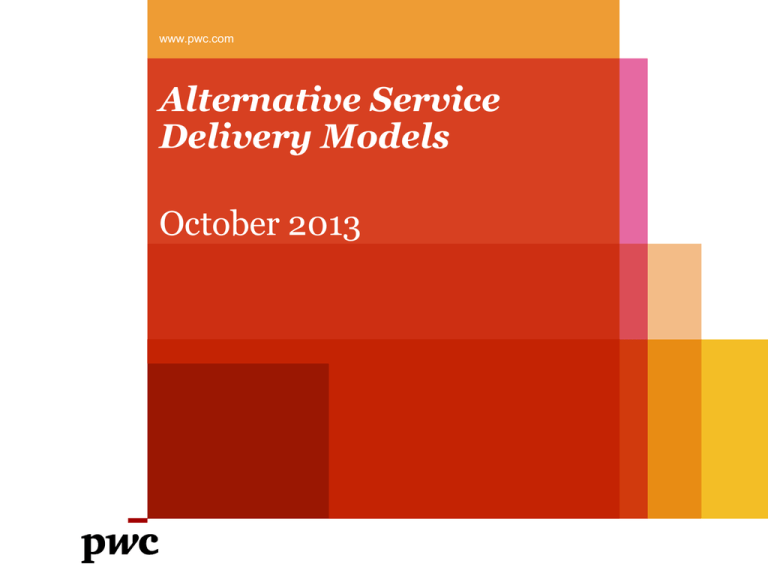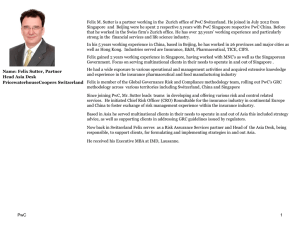
www.pwc.com
Alternative Service
Delivery Models
October 2013
Alternative Service Delivery Models
Background and Context
ASDN - Impact on Internal Audit
PwC
October 2013
2
Blurring the boundaries
Delivering public services
• Prioritisation of activities in the
context of cost efficiency drives the
need to consider a wider range of delivery
methods. These include not delivering the
service at all and letting the market
deliver it, if the need is there.
• Third parties (e.g. private sector, social
enterprise, communities) can be involved
in the delivery of public services to
achieve better value for money where
appropriate. Where the decision is to
involve a third party, the underlying
commercial reality of the deal (e.g. value,
governance, operations, risk transfer and
staff) will drive the use of different
commercial delivery models.
ASDN - Impact on Internal Audit
PwC
October 2013
3
Choosing the right model for your needs
Influences and pressures
Control
Policy
Risk
Localism
Efficiency
Benefits
Commerciality
Community
Cost
Provider
Commissioner
Governance
Influence
ASDN - Impact on Internal Audit
PwC
Strategy
October 2013
4
Choosing the right model for your needs
Process
Feasibility
Strategy
Objectives
Vision
Policy
Optional
appraisal
Business Case
Stakeholder
management
Benefits analysis
Risk
assessments
ASDN - Impact on Internal Audit
PwC
Structuring
Implementation
Structuring
Implement
Vesting/Reform
/ transaction
Project Plan
Benefit realisation
Capability
Capacity
October 2013
5
Reviewing service delivery models…
Big Society and
Localism
Increasing
demand and
shrinking
resources
Place Based
Budgets
Commissioner
vs. Provider
Collaboration
Agenda
Risk
Control
Policy
Financial
Pressures
Governance
Pressure on
Partner
Organisations
Strategy
Benefits
Options Analysis
Retain In-House
Private Sector Partnerships
Public-Public Partnerships
Public-Social Partnerships
NO “ONE SIZE FITS ALL” SOLUTION
ASDN - Impact on Internal Audit
PwC
October 2013
6
Key features
Retain InHouse
PublicPrivate
PublicPublic
The organisation retains all
responsibility for delivering the
service.
- outsourced entirely, or a joint
venture setup with a partner;
The partnership can operate on
a contractual basis, via SLAs,
on a constitutional basis, or a
joint venture can be setup.
There are a number of potential
vehicles, the main ones being
Social Enterprise, Mutuals or
Cooperatives.
For SLAs, the relationship is
contractual with one public
sector organisation delivering
service to another.
A Social Enterprise is a
socially-oriented venture
created with other
organisations , often involving
local communities on a not-forprofit basis.
- For outsourcing, an external
private sector partner is paid
to provide the service to or on
behalf of the organisation;
- For Joint ventures, a legal
entity is setup between the
parties to jointly deliver the
service for a finite period of
time. Typically, the private
sector partner is the majority
shareholder in these
arrangements.
A shared service is where the
delivery of a service is shared
between public sector
organisations using a
constitutional arrangement for
governance and equity.
For Joint ventures, a legal
entity is setup between the
parties to jointly deliver the
service via contracts.
ASDN - Impact on Internal Audit
PwC
PublicSocial
A mutual is an enterprise which
is owned by those who do
business with it.
A cooperative is similar to a
mutual as it is owned by those
who do business with it, but
generally deals in goods and
products rather than services.
October 2013
7
Alternative Service Delivery Models
Impact on Internal Audit
ASDN - Impact on Internal Audit
PwC
October 2013
8
Case Study 1 – Private Sector Provider Outsourcing
Local Authority
Objective
Key Issues
Maximising
cost
effectiveness
and
delivering a
return on
investment
•
Contractual arrangement between the LA and a
private provider to deliver an agreed service.
•
Able to obtain value from scale advantages of
existing providers, flexible pricing, reduced
upfront costs and output-based incentives.
•
Typically requires setup costs to cover any
procurement, the TUPE of staff and potentially the
redesign of the retained organisation.
•
Able to access skills available in the wider market
and to contract for defined outcomes.
•
Can be sufficiently flexible to allow for services to
be changed over time.
•
Contract management is important to maintain
overall service quality.
•
Enables strategic control of service whilst
transferring operational control.
Service
Agreement
Maintaining
or improving
service
quality
Supplier
Strategic Fit
ASDN - Impact on Internal Audit
PwC
October 2013
9
Outsourcing – Risks and Impact on IA
Local Authority
Service delivery risks –
reputation risks cannot be
transferred
Managing the strategic
relationship
‘duck the
bullet’ ?
Skills and capability
to effectively manage
the contract?
Or
Service
Agreement
Supplier
Strength of 1st and
2nd Lines of Defence
IA capability to
assure?
ASDN - Impact on Internal Audit
PwC
Do internal
audit….
Look to
drive more
assurance
from more
sources?
October 2013
10
Outsourcing – Risks and Impact on IA
1st & 2nd LoD
Align and focus risk
management activity
Clarify and define the
risk and audit universe.
Identify the gap between
proposed audit areas and
total risk universe.
More
Assurance
– More
Sources
Independent third
party assurance over
design and operation
of key controls for
outsourced contracts
and shared services.
3rd LoD
PwC
Robust contract
management
1st & 2nd LoD
11
Case Study 2 – Mutual
Local
Authority
X%
Ownership
Employees/
Clients
Y%
Ownership
Objective
Key Issues
Maximising
cost
effectiveness
and
delivering a
return on
investment
•
No legal construct. Organisation can take different
corporate forms (society, company). Can trade for
profit, but any surplus is returned to the members.
•
Could achieve cost reductions in service due to
scale increase or sharing of expertise with other
public sector partners.
•
Does not allow the Council to benefit from any
additional revenues as any profit could not be
redistributed. Vesting costs could be significant.
•
The ability to reward clients and employees
directly through their shareholding or membership
may improve services through incentivising them
to accurately reflect user needs.
•
The reduced ability to attract external private
sector partners may limit the ability to provide
service improvements.
•
Strategic control of the company is difficult for the
Council to maintain as the shares would typically
be owned by its employees or the users of the
12
service.
Mutual
Service
Agreement
Maintaining
or improving
service
quality
Council/Clients
Strategic Fit
ASDN - Impact on Internal Audit
PwC
Mutual – Risks and Impact on IA
Local
Authority
X%
Ownership
Employees/
Clients
Y%
Ownership
Mutual
Service
Agreement
Council/Clients
Operational risk - transfer of
people to a new company under
new management
Financial risk due to the
initial investment in vesting
costs
Succession planning
and investment to
remain upskilled
Governance
structures
Fraud and error
risks
ASDN - Impact on Internal Audit
PwC
Do internal
audit….
Adopt the
same
approach?
Or
Adopt a more
collaborative
approach?
October 2013
13
Mutual – Risks and Impact on IA
Policies,
procedures
Train
and involve
Support
&
collaborate
What does good
governance look
like?
Clarify risk
appetite
Where do
boundary
lines
lie?
Advise on risk
profile
Clarify risk
strategy
Embedding
key controls
Controls
optimisation
ASDN - Impact on Internal Audit
PwC
October 2013
14
Adding value for our clients
Chris Gallagher
Director – PwC
Tel:
+44(0)161-245 2484
Mobile: +44(0)7801-823 290
This publication has been prepared for general guidance on matters of interest only, and does
not constitute professional advice. You should not act upon the information contained in this
publication without obtaining specific professional advice. No representation or warranty
(express or implied) is given as to the accuracy or completeness of the information contained
in this publication, and, to the extent permitted by law, PricewaterhouseCoopers LLP, its
members, employees and agents do not accept or assume any liability, responsibility or duty
of care for any consequences of you or anyone else acting, or refraining to act, in reliance on
the information contained in this publication or for any decision based on it.
© 2013 PricewaterhouseCoopers LLP. All rights reserved. In this document, “PwC” refers to
PricewaterhouseCoopers LLP (a limited liability partnership in the United Kingdom) which is a
member firm of PricewaterhouseCoopers International Limited, each member firm of which is
a separate legal entity.









